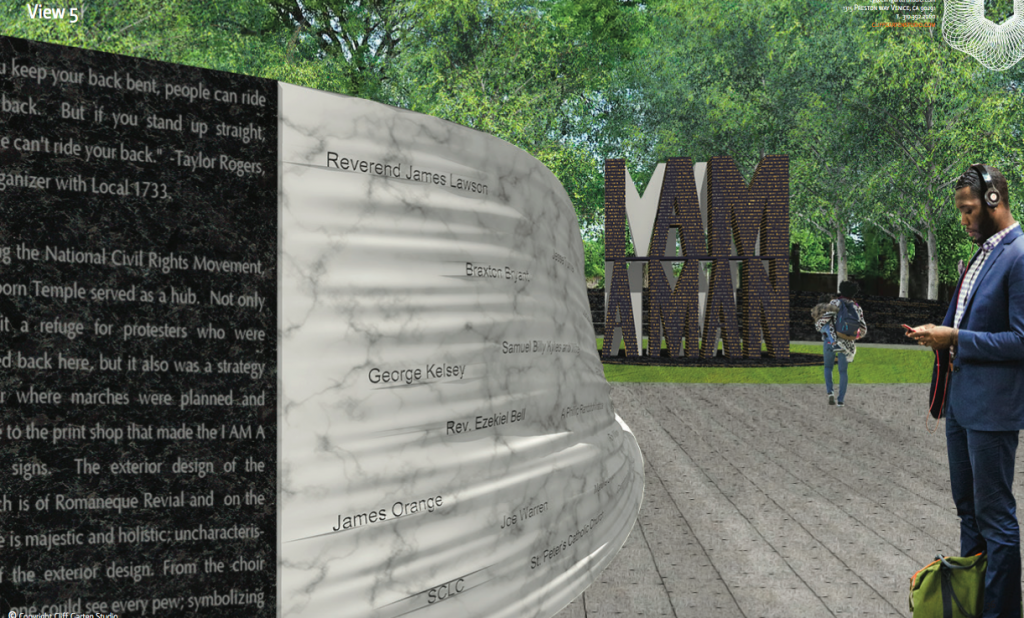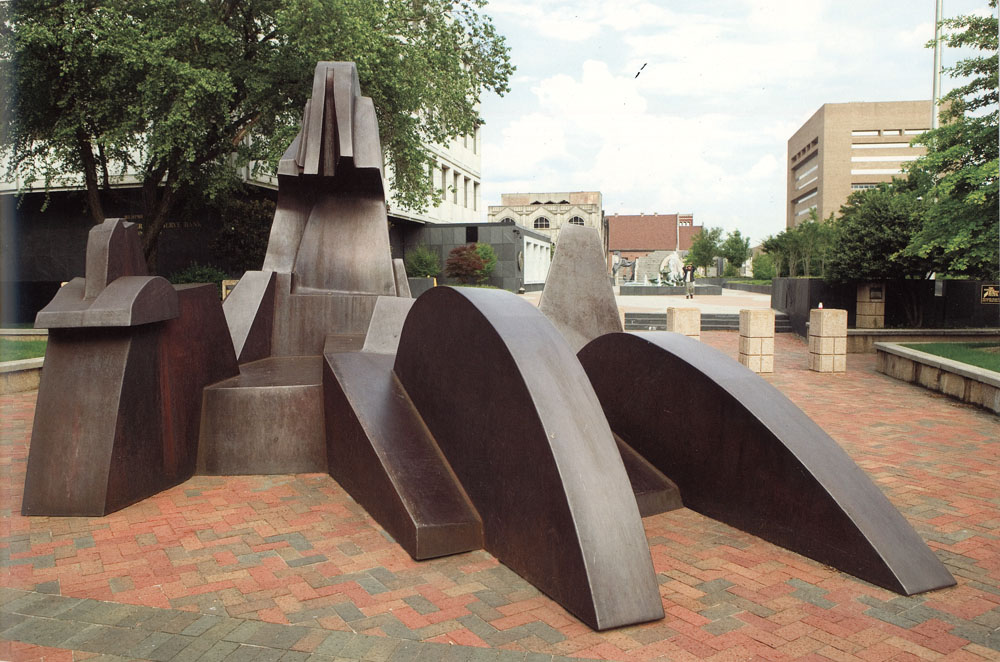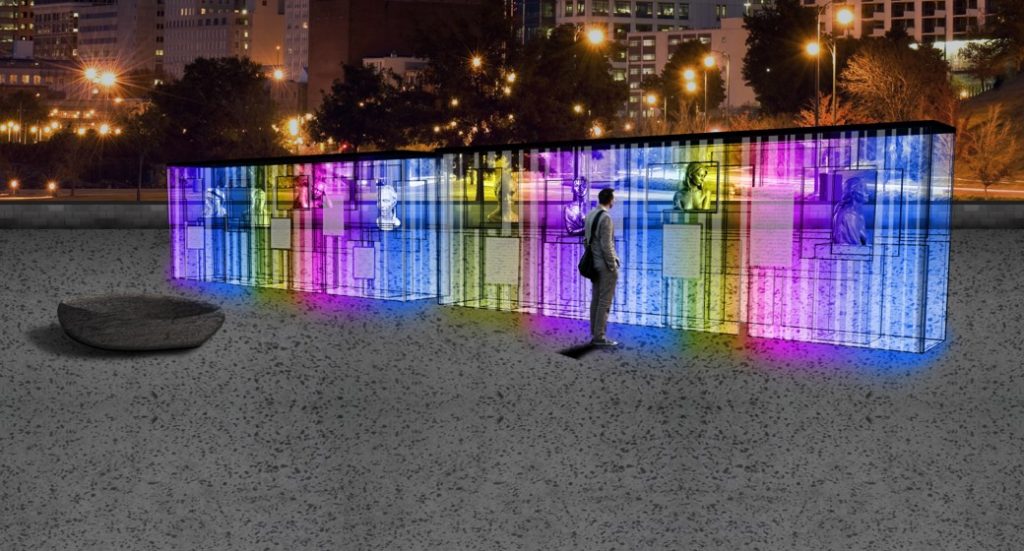It is said that a city’s monuments reflect its core values, which was a primary reason that Memphis’ Confederate statues had to go. In the coming 15 months, three statues will powerfully underscore this point by focusing on the values of equal rights, social activism, and the power of individuals to change history.
Two sculptures – a new one at the I AM A MAN Plaza and a relocated one at MLK Reflection Site – will be in place to commemorate the 50th anniversary of the April 4 murder of Dr. Martin Luther King Jr.
Another new one, which has not been publicized at this point, will honor Shelby County’s pivotal role in the passage of the 19th Amendment to the U.S. Constitution giving women the right to vote and it will be erected in celebration of the city’s bicentennial in spring, 2019.
All three sculptures will become part of the City of Memphis’ Heritage Trail project, whose spine will feature a walking trail (akin to the Black Heritage Trail in Boston) that honors the African American business, intellectual, and cultural journey as part of a 20-block economic development and community revitalization project whose primary borders are Beale Street on the North, Main Street on the West, E. H. Crump Boulevard on the South, and Walnut Street on the East.
“Heritage Trail is using cultural tourism as an economic driver by connecting the dots between historical, cultural, and community assets,” said Felicia L. Harris, Heritage Trail project manager with the Memphis Division of Housing and Community Development. “It embraces economic development, recreation and education, and preservation, weaving all of these together to create a conservation strategy.”
I AM A MAN and Mountaintop
An anchor for Heritage Trail – conceived four years ago as part of the $250 million South City project to redevelop Memphis’ last public housing complex with the city’s final HOPE VI federal funding – will be the $1.5 million I AM A MAN Plaza at Hernando Street and Pontotoc Avenue just south of Clayborn Temple, the historic church that acted as nerve center for many of the 1968 protest marches and that is now being renovated.
The plaza, to be opened for the 50th commemoration, is designed by Cliff Garten Studio of Venice, California, and celebrates Memphis home-grown heroes: protesting sanitation workers. Their names will be etched onto two curved walls framing the centerpiece – an oversized sculpture of the iconic placard carried by protesters: I AM A MAN.
A couple of blocks of the plaza at the northwestern corner of Second Street and Dr. M.L. King Jr. Avenue will be the MLK Reflection Site, new home for “I Have Been to the Mountaintop,” a signature work by preeminent 20th century sculptor Richard Hunt of Chicago that finally will get the extra love that it has long deserved.’ His sculptures are notable for bridging the gap between abstract art and the black experience in America.
“I Have Been to the Mountaintop” was placed in 1977 in a highly visible location on Civic Center Plaza between City Hall and the Shelby County Building but was moved years later for flimsy reasons by people who did not like the sculpture and justified by construction of the Main Street trolley. It was moved a half block north to a new home in front of the Cannon Center, crowded into a space between the trolley tracks and the wall of the federal reserve bank.
Giving A Sculpture The Site It Deserves
With the MLK Reflection Site, the monumental cor-ten steel sculpture – with its convex curves welded together with sweeping forms resembling a small mountain with a man coming out of it – will recognize one of America’s most famous African American sculptors and a sculpture constructed only 13 years after the statue of Jefferson Davis in what was called Confederate Park at the time.
In its new location, the sculpture will be perched on a pedestal to discourage the skateboarding which it has attracted from its first days (although Mr. Hunt has been quoted as saying that he had no problem with this).
Described by some city officials as a “meditation garden,” the MLK Reflection Site will feature three reflection pools, extensive landscaping, and benches. Memphis landscape architect John Jackson and Memphis firm Allworld Project Management are leading the design and construction process.
“It’s a place where people can reflect on the life and work of Dr. King and reflect on where we go from here to continue his legacy,” said Harris.
Women Suffrage Trailblazers for Equality
A third sculpture, “Equality Trailblazers,” will be installed on Civic Center Plaza in front of City Hall in time for the Memphis Bicentennial in May, 2019. Memphis author, speaker, and leading women’s suffrage authority Paula Casey is spearheading the project and has raised $250,000 of the $850,000 budget for the sculpture by Nashville sculptor Alan LeQuire. The work will be mesmerizing with theatrical lighting, glass displays, and nine sculptures of Memphis suffrage leaders and women history makers (and one more, a man who led passage of the amendment).
It is part of Ms. Casey’s decades-long campaign to preserve, commemorate, and celebrate Tennessee’s pivotal role in passage of suffrage, and in support of it, there are now a “Perfect 36” book, school curriculum, video, and e-book. The campaign has already inspired sculptures in Nashville, Jackson, and Knoxville.
Ms. Casey embarked on her life’s work after her husband died in 1988. “I was trying to figure out what I wanted to do with my life,” she said. “Carol Lynn Yellin was talking with me about how she wanted to do a book on Tennessee’s pivotal role in the 1920 ratification. So, we decided to do a video first. She was working on other books. I contacted Denise DuBois who was at Channel 5 then and we had gone to UT-K together. She wrote the primary script for the video. It debuted at the National Women’s Political Caucus convention in 1989. I had sales in all 50 states.”
The research for the book uncovered new information, but there was a race for Mrs. Yellin was to get the book written while she battled cancer. “This great story in American history was treated as a footnote, not as the greatest nonviolent revolution that it actually was,” Ms. Casey said.
“The book was printed in May, 1998, and Carol Lynn died on March 15, 1999.” Ms. Casey is now publisher for the second edition of the Perfect 36 as well as the e-books, audiobook, and DVD.
Original Persisters
While employed in Jim Strickland’s law office in 2012, she was working on the suffrage sculpture in Nashville when he told her that Memphis should have its own sculpture, and now with him in the Memphis mayor’s office, she is committed to having the artwork in place on Civic Center Plaza in time for the city’s 200th anniversary.
“Public art is forever,” she said. “Carol Lynn always said these women were the greatest politicians the world has ever seen and they deserve to be remembered. We want this to be a gift to the city for the bicentennial. I feel this sense of urgency to get this done and to honor these women.”
The honored women in the sculpture are early suffragists Elizabeth Avery Meriwether and Lide Smith Meriwether; later suffragists Lulu Colyar Reese and Charl Ormond Williams; anti-lynching journalists Ida B. Wells; Public Accommodations Act leader Mary Church Terrell; first women to receive a Tennessee law degree, Marion Griffin; Memphis civil rights leader Maxine Smith; and Minerva Johnican, first African American women to serve on Memphis City Council and Shelby County Board of Commissioners.
These women were “the original ‘persisters’ and all American women vote today because of it,” she said.
The Power of Public Art
However, there is one man in the sculpture: Memphis state representative Joe Hanover, whose work as floor leader led to Tennessee’s voting in favor of the Constitutional Amendment. “He is a real hero, a Polish immigrant, and the Tennessee vote would not have happened without him,” she said. With seven Southern states having already rejected the amendment, Tennessee was considered unlikely to vote yes, but it did, becoming the 36th state required for passage of the amendment that recognized women’s right to vote.
Ms. Casey could be referring to all three of the sculptures – suffrage, sanitation workers and Dr. King – when she said: “Public art is a magnet that attracts people and it’s important because it depicts what we as a society think is important.”
Ultimately, that is the reality that drove Memphis to remove its Confederate monuments and instead celebrate the best of human behavior with these three sculptures.
***
Join us at the Smart City Memphis Facebook page for daily articles, reports, and commentaries relevant to Memphis.









Public art is important however it needs to be good public art. Unfortunately I find all three of these monuments poorly done. The “I Am A Man” and “Mountaintop” sculptures are especially banal. I hope both are not defaced by graffiti and etchings are not turned into a skateboard park. The “Equality” monuments reminds me of a LED movie theatre marquee and resembles public art that’s been around for decades in other places. Public art is good, but surely we can do better.
Memphis 3.0:
take down horse.
put up sign.
sing songs.
meanwhile: new billboard seen entering South Memphis-‘Call Crimestoppers….
life goes on in the decaying river town.
I hate to say it but all 3 of these statues are just real ugly. Why not just a dignified statue of Dr. King? I hope the city maintains them do that they don’t fall into disrepair like Mud Island.
All of these so called statues look like they were thrown together to meet a deadline without a lot of thought. I’d love to see public art that is more compelling and thoughtful. It’s especially important that they try to engage the viewers. Without knowing the full information of where these are located, their size, materials used, etc it’s hard to tell. But from all we can see these three are really underwhelming. Surely we can do better to honor Dr Kinds snd the women’s suffrage movement.
I always thought the “Mountaintop” sculpture was ugly .There should be an inspirational statue of MLK in front of the NCRM. Around the sculpture should be a inviting area for people to sit, meet and congregate.
It’s not just the one. All of these statues seem ugly! Nothing inspirational about any of them.
Why should Memphis copy other cities? I’ve Been To The Mountaintop is a major, monumental work of art by one of the country’s greatest African American sculptors. for all the armchair critics, these have been in the works for years, so they aren’t rush jobs. They are as unique as Memphis and they should be.
Troglodytes, we’ve finally found something you agree on.
Richard Hunt:
Honors and awards
Art Institute’s Logan Prize, 1956
Elected into the National Academy of Design, 1999
Lifetime Achievement Award, International Sculpture Center, 2009
Selected works
A Bridge Across and Beyond (1978), Washington, D.C.
Symbiosis (c. 1981), Washington, D.C.
Build-Grow (1986), Jamaica, Queens, New York
Build-Grow (1992), Washington, D.C.
Selected collections
Minneapolis Institute of Art, Minneapolis, MN
Public collections
Albright-Knox Gallery, Buffalo, New York
Art Institute of Chicago, Chicago, Illinois
Birmingham Museum of Art, Birmingham, Alabama
Brauer Museum of Art, Valparaiso, Indiana
Butler Institute of American Art, Youngstown, Ohio
Cincinnati Art Museum, Cincinnati, Ohio
Cleveland Museum of Art, Cleveland, Ohio
Denver Art Museum, Denver, Colorado
Detroit Institute of Arts, Detroit, Michigan
DuSable Museum, Chicago, Illinois
Frederik Meijer Gardens and Sculpture Park, Grand Rapids, Michigan
Greenville County Museum of Art, Greenville, South Carolina
Hirshhorn Museum and Sculpture Garden, Washington, D.C.
Hunter Museum of Art, Chattanooga, Tennessee
Indianapolis Museum of Art, Indianapolis, Indiana
Kalamazoo Institute of Arts, Kalamazoo, Michigan
Lakeview Museum of Arts and Sciences, Peoria, Illinois
Laumeier Sculpture Garden, St Louis, Missouri
Los Angeles County Museum, Los Angeles, California
New Jersey State Museum of Art, Trenton, New Jersey
Metropolitan Museum of Art, New York, New York
Milwaukee Art Museum, Milwaukee, Wisconsin
Museum of Contemporary Art, Chicago, Illinois
Museum of Modern Art, New York, New York
Museum of the Twentieth Century, Vienna, Austria
Nassau County Museum of Art, Roslyn, New York
National Academy Museum, New York, New York
National Gallery, Washington, DC
National Museum of American Art, Washington, DC
National Museum of Israel, Jerusalem, Israel
Nelson-Atkins Museum of Art, Kansas City, Missouri
Sheldon Swope Art Museum, Terre Haute, Indiana
Smart Museum of Art, University of Chicago, Chicago, Illinois
Smithsonian American Art Museum, Washington, DC
Snite Museum of Art, Notre Dame University, Notre Dame, Indiana
Speed Art Museum, Louisville, Kentucky
Springfield Art Museum, Springfield, Missouri
Storm King Art Center, Mountainville, New York
Swope Art Museum, Terre Haute, Indiana
Telfair Museum, Savannah, Georgia
University of Michigan, courtyard Bentley Historical Museum, Ann Arbor, Michigan
Virginia Museum of Fine Arts, Richmond, Virginia
Weatherspoon Art Museum, University of North Carolina, Greensboro, North Carolina
Whitney Museum of American Art, New York, New York
Wichita Art Museum, Wichita, Kansas
York College, Jamaica, Queens, New York.
I’m sorry Frank but the only thing monumental about any of these so-called art is their ugliness. All the honors and awards of the sculptor can’t hide this. I simply prefer something inspiring and that looks somewhat normal. All of these are just tacky, especially the “mountaintop”
Chicago sculptor Richard Hunt’s six-decade career gets two concurrent exhibits
As Hunt nears 80, the Museum of Contemporary Art and the Cultural Center mine nearly 60 years of the artist’s work.
By Aimee Levitt @aimeelevitt
Untitled (1963) by Richard Hunt
Untitled (1963) by Richard Hunt
NATHAN KEAY
[Recommended] “Richard Hunt: 60 Years of Sculpture”
Through 3/29/15
Chicago Cultural Center
78 W. Washington
312-744-6630
cityofchicago.org
Free
[Recommended] “Richard Hunt”
Opens Thu 12/18
Through 5/17/15
Museum of Contemporary Art
220 E. Chicago
312-280-2660
mcachicago.org
When the sculptor Richard Hunt was still a student at the School of the Art Institute, he sold a piece to the Museum of Modern Art in New York. That was back in 1957; Hunt was 22. When he was 35, in 1971, MOMA mounted the first retrospective of his work. Hunt is nearing 80 now, but he continues to work in his Lincoln Park studio, welding industrial metal into art. Several pieces from his personal collection, covering the full range of his nearly 60-year-long career, from his student days through work currently in progress, is on display at the Chicago Cultural Center through March. The Museum of Contemporary Art salutes Hunt with a retrospective, opening this week, featuring pieces (mostly) drawn from its own collection.
“It’s rare to see an artist active for so long,” says Naomi Beckwith, the MCA curator who put the exhibit together. “You can see how things have shifted from his early work, the shift in scale, the shift in form. The early work is more figurative, but the later work pushes toward real abstraction.”
That’s certainly not to say Hunt is inaccessible—his sculptures have appeared everywhere, from the offices of Playboy Enterprises to Midway airport.
Although Hunt wasn’t the first artist to work with industrial materials—he was strongly influenced by the Spanish sculptor Julio González, whose work was shown in Chicago in the 50s—he stands out, Beckwith says, because of the expressiveness of his forms. Unlike his contemporary Tony Smith, who embraced minimalism, Hunt, in his sculpture, sought to re-create the fluid lines of drawing. Along the way, he also became a master welder. While in his earlier output it’s possible to see the seams, his later sculptures look like, as Beckwith puts it, “one solid piece of metal extending into space.
“The material doesn’t look like it should be able to do the things it does,” she says. “There’s a sense of vivacity—of aliveness and energy. There’s metal all around us, in buildings and in our cars, but it’s a magical moment to watch metal transform from something mundane and utilitarian into something poetic.”
So MSU-02, all the critics are wrong? You know more than all them do. Classic.
And I’m sure the Museum of Modern Art is wrong: “Richard Hunt ranks as one of America’s foremost living sculptors.
There’s an old saying about someone: “The only taste he has is in his mouth.”